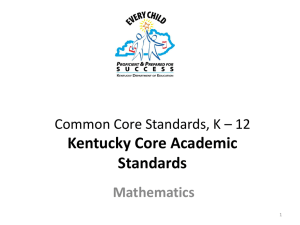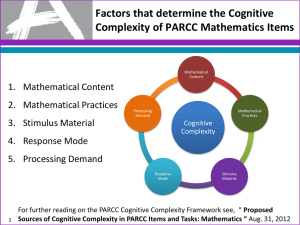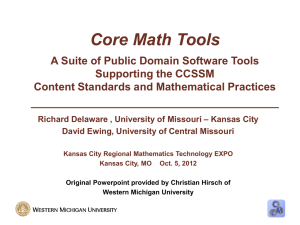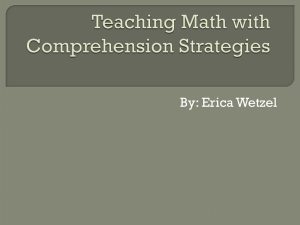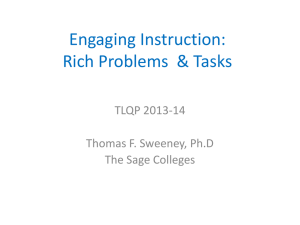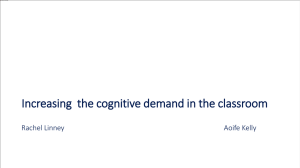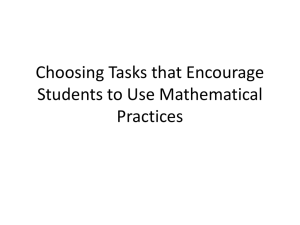NCTM Scope and Sequence - Department of Mathematical Sciences
advertisement
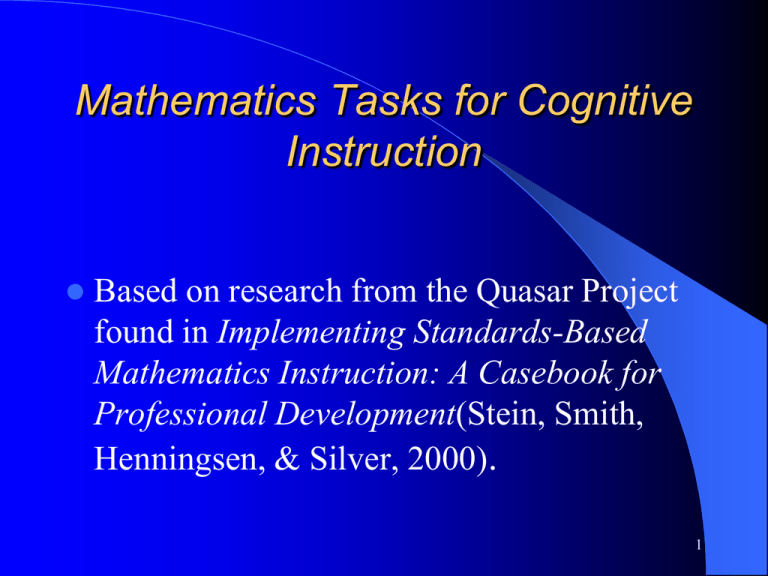
Mathematics Tasks for Cognitive Instruction Based on research from the Quasar Project found in Implementing Standards-Based Mathematics Instruction: A Casebook for Professional Development(Stein, Smith, Henningsen, & Silver, 2000). 1 NCTM Standards Compared to Connecticut Scope and Sequence Connecticut Scope and Sequence Number Sense Operations Estimation Ratio, Proportion and Percent Measurement Spatial Relations and Geometry Probability and Statistics Patterns Algebra and Functions Discrete Mathematics NCTM Content Standards Numbers and Operations Algebra Data Analysis and Probability Geometry Measurement NCTM Process Standards Problem Solving Reasoning and Proof Connections Communication Representation 2 NCTM and CT Scope and Sequence http://www.nctm.org http://www.sde.ct.gov/ sde/cwp/view.asp?a=2 618&q=320872 3 Common Core State Standards http://www.corestandards.org/ 4 The Mathematical Tasks Framework TASKS as they appear in curricular/ instructional materials TASKS as set up by teacher TASKS as implemented by students Student Learning A representation of how mathematical tasks unfold in the classroom during classroom instruction (Stein & Smith, 1998) 5 Levels of Cognitive Demand as Compared to Bloom’s Taxonomy Highest Levels Doing Math Procedures with Connections Procedures without Connections Memorization Lowest Levels 6 Defining Levels of Cognitive Demand of Mathematical Tasks Lower Level Demands – Memorization – Procedures without connections Higher Level Demands – Procedures with Connections – Doing Mathematics 7 Verb Examples Associated with Each Activity Lower Level of Cognitive Demands Knowledge: arrange, define, duplicate, label, list, memorize, name, order, recognize, relate, recall, repeat, reproduce state. Comprehension: classify, describe, discuss, explain, express, identify, indicate, locate, recognize, report, restate, review, select, translate. 8 Defining Levels of Cognitive Demands of Mathematical Tasks Lower Level Demands Memorization: What are the decimal and percent equivalents for the fractions ½ and ¼ ? 9 Defining Levels of Cognitive Demands of Mathematical Tasks Lower Level Demands Memorization: What are the decimal and percent equivalents for the fractions ½ and ¼ ? Expected Student Response: ½=.5=50% ¼=.25=25% 10 Defining Levels of Cognitive Demands of Mathematical Tasks Lower Level Demands Procedures without connections: Convert the fraction 3/8 to a decimal and a percent. Expected Student Response: Fraction 3/8 Divide 3 by 8 and get a decimal equivalent of .375 Move the decimal point two places to the right and get 37.5 % 11 Verb Examples Associated with Each Activity Higher levels of cognitive demand Application: apply, choose, demonstrate, dramatize, employ, illustrate, interpret, operate, practice, schedule, sketch, solve, use, write. Analysis: analyze, appraise, calculate, categorize, compare, contrast, criticize, differentiate, discriminate, distinguish, examine, experiment, question, test. 12 Defining Levels of Cognitive Demands of Mathematical Tasks Higher Level Demands Procedure with connections: Using a 10 by 10 grid, illustrate the decimal and percent equivalents of 3/5. 13 Verb Examples Associated with Each Activity Highest levels of cognitive demands Synthesis: arrange, assemble, collect, compose, construct, create, design, develop, formulate, manage, organize, plan, prepare, propose, set up, write. Evaluation: appraise, argue, assess, attach, choose, compare, defend estimate, judge, predict, rate, core, select, support, value, evaluate 14 Defining Levels of Cognitive Demands of Mathematical Tasks Higher Level Demands Doing Mathematics: Shade 6 small squares in a 4 X 10 rectangle. Using the rectangle, explain how to determine each of the following: A) the percent of area that is shaded B) the decimal part of the area that is shaded C) the fractional part of the area that is shaded 15 Comparing Two Mathematical Tasks Martha’s Carpeting Task The Fencing Task 16 Martha’s Carpeting Task Martha was recarpeting her bedroom, which was 15 feet long and 10 feet wide. How many square feet of carpeting will she need to purchase? 17 The Fencing Task Ms. Brown’s class will raise rabbits for their spring science fair. They have 24 feet of fencing with which to build a rectangular rabbit pen to keep the rabbits. a) If Ms. Brown’s students want their rabbits to have as much room as possible, how long would each of the sides of the pen be? b) How long would each of the sides of the pen be if they had only 16 feet of fencing? c) How would you go about determining the pen with the most room for any amount of fencing? Organize your work so that someone else who reads it will understand it. Source: Stein, Smith, Henningsen, & Silver, (2000) 18 Comparing Two Mathematical Tasks Think privately about how you would go about solving each task Talk with your neighbor about how you could solve each of the tasks –The Fencing Task –Martha’s Carpeting Task 19 Martha’s Carpeting Task Using the Area Formula A=lxw A = 15 x 10 A = 150 square feet 20 Martha’s Carpeting Task Drawing a Picture 10 15 21 The Fencing Task Diagrams on Grid Paper 22 The Fencing Task Using a Table Length Width Perimeter Area 1 11 24 11 2 10 24 20 3 9 24 27 4 8 24 32 5 7 24 35 6 6 24 36 7 5 24 35 23 The Fencing Task Graph of Length and Area 40 35 30 Area 25 20 15 10 5 0 0 1 2 3 4 5 6 7 8 9 10 11 12 13 Length 24 Comparing Tasks How are Martha’s Carpeting Task and the Fencing Task the same and how are they different? 25 Similarities and Differences Similarities Differences 26 Similarities and Differences Similarities Both are “area” problems Both require prior knowledge of area Differences The amount of thinking and reasoning required The number of ways the problem can be solved Way in which the area formula is used The need to generalize Many ways to enter the problem 27 Mathematical Tasks: A Critical Starting Point for Instruction Not all tasks are created equal, and different tasks will provoke different levels and kinds of student thinking. Stein, Smith, Henningsen, & Silver, 2000 28 Mathematical Tasks If we want students to develop the capacity to think, reason, and problem solve then we need to start with high-level, cognitively complex tasks. Stein & Lane, 1996 29 What do you think? In what ways will you use your knowledge and understanding of cognitive demands in your role as teacher leader? 30


